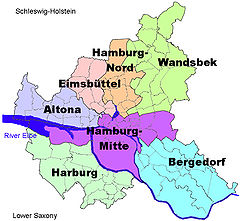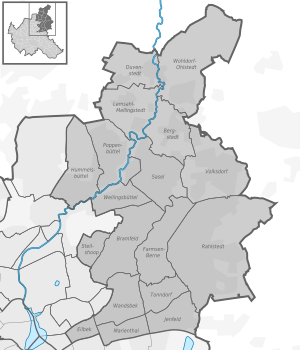| Wandsbek | |
|---|---|
| Borough of Hamburg | |
 Stormarnhaus in Wandsbek Stormarnhaus in WandsbekLocal office of the borough | |
 Flag Flag Coat of arms Coat of arms | |
Boroughs of Hamburg
 | |
  | |
| Coordinates: 53°35′N 10°5′E / 53.583°N 10.083°E / 53.583; 10.083 | |
| Country | Germany |
| State | Hamburg |
| City | Hamburg |
| Subdivisions | 18 quarters |
| Area | |
| • Total | 147.5 km (57.0 sq mi) |
| Population | |
| • Total | 455,185 |
| • Density | 3,100/km (8,000/sq mi) |
| Time zone | UTC+01:00 (CET) |
| • Summer (DST) | UTC+02:00 (CEST) |
| Dialling codes | 040 |
| Vehicle registration | HH |
Wandsbek (German pronunciation: [ˈvantsbeːk] ) is the second-largest of seven boroughs that make up the city and state of Hamburg, Germany. The name of the district is derived from the river Wandse which passes through here. Wandsbek, which was formerly an independent city, is urban and, along with Eilbek and Marienthal, part of the city's economic and cultural core. In 2020 the population was 442,702, making it the most populous borough in Hamburg.
History
Wandsbek was the place of residence of the poet Johann Heinrich Voss and of Matthias Claudius, who here issued (1771–1775) the newspaper Der Wandsbecker Bote (The Wandsbeck Messenger). There is a monument to Claudius in the town.
During World War II from May 2, 1944 until May 3, 1945 a subcamp of the Nazi concentration camp of Neuengamme was located in Wandsbek, listed as no. 565 Hamburg-Wandsbek in the official German list.
On January 1, 2007 the Ortsämter (Precincts) were dissolved and the organisation of all boroughs of Hamburg was restructured. In the borough Wandsbek to the former precinct Wandsbek had belonged the quarters Eilbek, Jenfeld, Marienthal, Tonndorf, Wandsbek and Rahlstedt. The quarters Hummelsbüttel, Poppenbüttel, Sasel and Wellingsbüttel belonged to the precinct Alstertal. The precinct Bramfeld consisted of Bramfeld and Steilshoop. The precinct Rahlstedt were the quarter Rahlstedt. And the precinct Walddörfer were Bergstedt, Duvenstedt, Farmsen-Berne, Lemsahl-Mellingstedt, Volksdorf and Wohldorf-Ohlstedt.
Geography
In 2006 according to the statistical office of Hamburg and Schleswig-Holstein, the borough Wandsbek had a total area of 147.5 km (57 sq mi). In the north and the east it borders the state of Schleswig-Holstein, in the south the Hamburg-Mitte borough and in the west Hamburg-Nord borough mostly. Only three quarters, Eilbek, Wandsbek, and Marienthal, in the core of the borough are urban. The more northerly parts of Wohldorf-Ohlstedt, Volksdorf, Duvenstedt are still quite rural, where one can find a mix of newer residences and farms.
Administrative divisions

Like the other boroughs of Hamburg, Wandsbek is divided into quarters. They are:
| Quarter | km | Residents
(2014) |
Quarter | km | Residents
(2014) |
|---|---|---|---|---|---|
| Bergstedt | 7,1 | 10.216 | Bramfeld | 10,1 | 50.838 |
| Duvenstedt | 6,8 | 6.253 | Eilbek | 1,7 | 20.981 |
| Farmsen-Berne | 8,3 | 34.664 | Hummelsbüttel | 9,2 | 17.180 |
| Jenfeld | 5,0 | 24.751 | Lemsahl-Mellingstedt | 7,9 | 6.556 |
| Marienthal | 3,3 | 12.358 | Poppenbüttel | 8,1 | 22.536 |
| Rahlstedt | 26,6 | 88.094 | Sasel | 8,4 | 23.366 |
| Steilshoop | 2,5 | 19.273 | Tonndorf | 3,9 | 13.691 |
| Volksdorf | 11,6 | 20.372 | Wandsbek | 6,0 | 33.591 |
| Wellingsbüttel | 4,1 | 10.415 | Wohldorf-Ohlstedt | 17,3 | 4.475 |
Demographics
The population of Wandsbek in 2006 was 409,771 people. The population density was 2,777 inhabitants per square kilometre (7,192/sq mi). 16.5% were children under the age of 18, and 22% were 65 years of age or older. 10.1% were immigrants. 18,452 people were registered as unemployed. In 1999 there were 200,560 households, out of which 21.2% had children under the age of 18 living with them and 41.6% of all households were made up of individuals. The average household size was 2.02.
In 2006 there were 37,957 criminal offences in the borough (93 crimes per 1,000 people).
Government
Wandsbek is a subdivision of Hamburg.
See also: Boroughs and quarters of Hamburg § BoroughsBorough Assembly
| Parties | % | ± | Seats | |
|---|---|---|---|---|
| Christian Democratic Union | 27.9 | 16 | ||
| Social Democratic Party | 27.7 | 16 | ||
| Alliance 90/The Greens | 19.4 | 11 | ||
| Alternative for Germany | 11.0 | 6 | ||
| The Left | 7.0 | 4 | ||
| Free Democratic Party | 6.9 | 4 | ||
| Total | 57 | |||
Infrastructure
There are 61 elementary and 46 secondary schools in the borough of Wandsbek, 695 physicians in private practice and 91 pharmacies.
According to the Department of Motor Vehicles (Kraftfahrt-Bundesamt), there are 171,334 private cars registered (421 cars/1000 people).
Points of interest
- Botanischer Sondergarten Wandsbek, a municipal botanical garden
- Wandsbek Studios of Studio Hamburg GmbH
See also
- Hamburg-Wandsbek (electoral district) the German federal parliamentary district covering the borough
- Seebek
- Jonathan Eybeschutz
Notes
- "Bevölkerung in Hamburg am 31.12.2023 nach Stadtteilen". Statistisches Amt für Hamburg und Schleswig-Holstein. May 2024.
-
 One or more of the preceding sentences incorporates text from a publication now in the public domain: Chisholm, Hugh, ed. (1911). "Wandsbek". Encyclopædia Britannica. Vol. 28 (11th ed.). Cambridge University Press. p. 303.
One or more of the preceding sentences incorporates text from a publication now in the public domain: Chisholm, Hugh, ed. (1911). "Wandsbek". Encyclopædia Britannica. Vol. 28 (11th ed.). Cambridge University Press. p. 303.
- Official German list of concentration camps Archived 2009-04-23 at the Wayback Machine Verzeichnis der Konzentrationslager und ihrer Außenkommandos gemäß § 42 Abs. 2 BEG (in German)
- Verwaltungsreform (administrational reform)
- Residents registration office, source: statistical office Nord of Hamburg and Schleswig-Holstein (2006)
- Source: statistical office Nord of Hamburg and Schleswig-Holstein (1999)
- State Investigation Bureaux (Landeskriminalamt), source: statistical office Nord of Hamburg and Schleswig-Holstein (2006)
- ^ Source: statistical office Nord of Hamburg and Schleswig-Holstein (2006)
References
- Statistical office Hamburg and Schleswig-Holstein Statistisches Amt für Hamburg und Schleswig-Holstein, official website (in German)
External links
| Freie und Hansestadt Hamburg | |
| Government and symbols | |
| History and culture | |
| Economy and transport | |